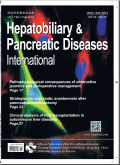- 钛学术文献服务平台 \
- 学术期刊 \
- 医药卫生期刊 \
- 内科学期刊 \
- 国际肝胆胰疾病杂志(英文版)期刊 \
null
Recent evolution of living donor liver transplantation at Kyoto University: How to achieve a one-year overall survival rate of 99%?
基本信息来源于合作网站,原文需代理用户跳转至来源网站获取
摘要:
Previously, living donor liver transplantation was considered as a "high-risk, high-return"medical treat- ment due to the relatively high short-term mortality. It is our task to change "high-risk, high-return"into a "low-risk, high-return"situation. In this review article, the recent evolutions in living donor liver trans- plantation for both donors and recipients at Kyoto University such as portal vein pressure modulation, hy- brid donor operation, and perioperative management considering sarcopenia, focusing on improvement of short-term outcomes are described. Under a paradigm of "marketing and innovation", various innovations and efforts have been made over the last decade aiming at improving the short-term outcomes of bothdonors and recipients. By doing so, excellent short-term results after living donor liver transplantation have been achieved, along with a potentially epoch-making discoveries.

推荐文章
期刊_丙丁烷TDLAS测量系统的吸收峰自动检测
带间级联激光器
调谐半导体激光吸收光谱
雾剂检漏 中红外吸收峰 洛伦兹光谱线型
不同盐度、温度及光照对漂浮浒苔生理生态的影响
浒苔
盐度
温度
光照
生理生态
期刊_联合空间信息的改进低秩稀疏矩阵分解的高光谱异常目标检测
高光谱图像
异常目标检测 低秩稀疏矩阵分解 稀疏矩阵 残差矩阵
内容分析
关键词云
关键词热度
相关文献总数
(/次)
(/年)
文献信息
| 篇名 | Recent evolution of living donor liver transplantation at Kyoto University: How to achieve a one-year overall survival rate of 99%? | ||
| 来源期刊 | 国际肝胆胰疾病杂志(英文版) | 学科 | |
| 关键词 | |||
| 年,卷(期) | 2020,(4) | 所属期刊栏目 | |
| 研究方向 | 页码范围 | 328-333 | |
| 页数 | 6页 | 分类号 | |
| 字数 | 语种 | 英文 | |
| DOI | |||
五维指标
引文网络
引文网络
二级参考文献 (58)
共引文献 (1)
参考文献 (36)
节点文献
引证文献 (0)
同被引文献 (0)
二级引证文献 (0)
1971(1)
- 参考文献(0)
- 二级参考文献(1)
1982(1)
- 参考文献(0)
- 二级参考文献(1)
1989(1)
- 参考文献(1)
- 二级参考文献(0)
1990(1)
- 参考文献(1)
- 二级参考文献(0)
1996(2)
- 参考文献(1)
- 二级参考文献(1)
1997(1)
- 参考文献(0)
- 二级参考文献(1)
2000(1)
- 参考文献(0)
- 二级参考文献(1)
2002(2)
- 参考文献(1)
- 二级参考文献(1)
2003(3)
- 参考文献(0)
- 二级参考文献(3)
2004(1)
- 参考文献(0)
- 二级参考文献(1)
2006(4)
- 参考文献(1)
- 二级参考文献(3)
2007(10)
- 参考文献(3)
- 二级参考文献(7)
2008(2)
- 参考文献(0)
- 二级参考文献(2)
2009(9)
- 参考文献(1)
- 二级参考文献(8)
2010(4)
- 参考文献(3)
- 二级参考文献(1)
2011(2)
- 参考文献(1)
- 二级参考文献(1)
2012(5)
- 参考文献(2)
- 二级参考文献(3)
2013(7)
- 参考文献(2)
- 二级参考文献(5)
2014(8)
- 参考文献(2)
- 二级参考文献(6)
2015(10)
- 参考文献(2)
- 二级参考文献(8)
2016(9)
- 参考文献(5)
- 二级参考文献(4)
2017(4)
- 参考文献(4)
- 二级参考文献(0)
2018(2)
- 参考文献(2)
- 二级参考文献(0)
2019(4)
- 参考文献(4)
- 二级参考文献(0)
2020(0)
- 参考文献(0)
- 二级参考文献(0)
- 引证文献(0)
- 二级引证文献(0)
引文网络交叉学科
相关学者/机构
期刊影响力
国际肝胆胰疾病杂志(英文版)
主办单位:
浙江大学医学院第一附属医院
出版周期:
双月刊
ISSN:
1499-3872
CN:
33-1391/R
开本:
大16开
出版地:
浙江省杭州市庆春路79号
邮发代号:
创刊时间:
2002
语种:
eng
出版文献量(篇)
1879
总下载数(次)
0
总被引数(次)
8662
期刊文献
相关文献
推荐文献
- 期刊分类
- 期刊(年)
- 期刊(期)
- 期刊推荐
国际肝胆胰疾病杂志(英文版)2022
国际肝胆胰疾病杂志(英文版)2021
国际肝胆胰疾病杂志(英文版)2020
国际肝胆胰疾病杂志(英文版)2019
国际肝胆胰疾病杂志(英文版)2018
国际肝胆胰疾病杂志(英文版)2017
国际肝胆胰疾病杂志(英文版)2016
国际肝胆胰疾病杂志(英文版)2015
国际肝胆胰疾病杂志(英文版)2014
国际肝胆胰疾病杂志(英文版)2013
国际肝胆胰疾病杂志(英文版)2012
国际肝胆胰疾病杂志(英文版)2011
国际肝胆胰疾病杂志(英文版)2010
国际肝胆胰疾病杂志(英文版)2009
国际肝胆胰疾病杂志(英文版)2008
国际肝胆胰疾病杂志(英文版)2007
国际肝胆胰疾病杂志(英文版)2006
国际肝胆胰疾病杂志(英文版)2020年第6期
国际肝胆胰疾病杂志(英文版)2020年第5期
国际肝胆胰疾病杂志(英文版)2020年第4期
国际肝胆胰疾病杂志(英文版)2020年第3期
国际肝胆胰疾病杂志(英文版)2020年第2期
国际肝胆胰疾病杂志(英文版)2020年第1期

 免费查重
免费查重










